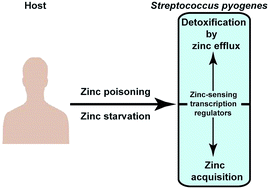Zinc’ing it out: zinc homeostasis mechanisms and their impact on the pathogenesis of human pathogen group A streptococcus
Abstract
Group A Streptococccus (GAS) is a major human pathogen that causes significant morbidity and mortality. Zinc is an essential trace element required for GAS growth, however, zinc can be toxic at excess concentrations. The bacterial strategies to maintain zinc sufficiency without incurring zinc toxicity play a crucial role in host–GAS interactions and have a significant impact on GAS pathogenesis. The host deploys nutritional immune mechanisms to retard GAS growth by causing either zinc deprivation or zinc poisoning. However, GAS overcomes the zinc-dependent host defenses and survives in the hostile environment by employing complex adaptive strategies. In this review, we describe the different host immune strategies that employ either zinc limitation or zinc toxicity in different host environments to control GAS infection. We also discuss the molecular mechanisms and machineries used by GAS to evade host nutritional defenses and establish successful infection. Emerging evidence suggests that the metal transporters are major GAS virulence factors as they compete against host nutritional immune mechanisms to acquire or expel metals and promote bacterial survival in the host. Thus, identification of GAS molecules and elucidation of the mechanisms by which GAS combats host-mediated alterations in zinc availability may lead to novel interference strategies targeting GAS metal acquisition systems.

- This article is part of the themed collection: Recent Review Articles


 Please wait while we load your content...
Please wait while we load your content...